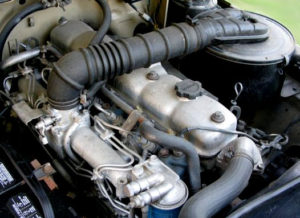
The 2H diesel engine has a cast-iron cylinder block with 91.0 mm (3.58 in) cylinder bores and a 102.0 mm (4.02 in) piston stroke. Compression ratio rating is 20.7:1. The motor has a cast iron cylinder head with the overhead valves (2 per cylinder, 12 in total).
The Toyota 2H engine produced 105 PS (77 kW; 103 HP) at 3,500 rpm or 109 PS (80 kW; 107 HP) at 3,500 rpm of maximum horsepower and 240 N·m (24.5 kg·m, 176.9 ft·lb) at 2,000 rpm of peak torque.
The breakdown of the engine code is as follows:
- 2 – 2-nd generation engine
- H – Engine family
General information
| Engine Specifications | |
| Engine code | 2H |
| Layout | Straight-6, vertical |
| Fuel type | Diesel |
| Production | – |
| Displacement | 4.0L, 3,980 cc (242.9 cu in) |
| Injection pump | Mechanical |
| Power adder | None |
| Horsepower net |
105 PS (77 kW; 103 HP) at 3,500 rpm 109 PS (80 kW; 107 HP) at 3,500 rpm |
| Torque output | 240 N·m (24.5 kg·m, 176.9 ft·lb) at 2,000 rpm |
| Firing order | 1-4-2-6-3-5 |
| Dimensions (L x H x W): | – |
| Weight | |
Cylinder block
The cylinder block is made of cast iron. The crankshaft is supported by 7 bearings. The crankshaft bearings are made of aluminum alloy. Pistons are made of highly temperature-resistant aluminum alloy.
The cylinder bore is 91.0 mm (3.58 in), piston stroke is 102.0 mm (4.02 in) and compression ratio rating is 20.7:1.
| Cylinder block | ||
| Cylinder block alloy | Cast iron | |
| Compression ratio: | 20.7:1 | |
| Cylinder bore: | 91.0 mm (3.58 in)) | |
| Piston stroke: | 102.0 mm (4.02 in) | |
| Number of piston rings (compression / oil): | 2 / 1 | |
| Number of main bearings: | 7 | |
| Cylinder bore inner diameter: | 91.000-91.030 mm (3.5827-3.5839 in) | |
| Piston skirt diameter | 90.930-90.940 mm (3.5799-3.5803 in) | |
| Piston ring groove: | First | 0.097-0.137 mm (0.0038-0.0054 in) |
| Second | 0.060-0.100 mm (0.0024-0.0039 in) | |
| Oil | 0.020-0.060 mm (0.0008-0.0024 in) | |
| Piston ring end gap: | First | 0.200-0.440 mm (0.0079-0.0173 in) |
| Second | 0.200-0.440 mm (0.0079-0.0173 in) | |
| Oil | 0.150-0.490 mm (0.0059-0.0193 in) | |
| Piston pin outer diameter | 29.000-29.012 mm (1.1417-1.1422 in) | |
| Connecting rod small end diameter (standard): | 29.008-29.020 mm (1.142-1.1425 in) | |
| Crankshaft main journal diameter: | 69.980-70.000 mm (2.7551-2.7559 in) | |
| Crankpin diameter: | 54.980-55.000 mm (2.1646-2.1654 in) | |
| Crankshaft center distance: | 51.0 mm (2.01 in) | |
Main bearing cap tightening procedure and torque specs:
- 136 Nm; 13.9 kg·m; 100 ft·lb
After securing bearing cap bolts, make sure crankshaft turns smoothly by hand.
Connecting rod bearing nut
- 88 Nm; 9.0 kg·m; 65 ft·lb
Crankshaft pulley bolt
- 441 Nm; 45.0 kg·m; 325 ft·lb
Drive plate (A/T) fixing bolts
- 98 Nm; 10.0 kg·m; 72 ft·lb
Flywheel (M/T) fixing bolts
- 118 Nm; 12.0 kg·m; 87 ft·lb
Cylinder head
| Cylinder head | |
| Cylinder head alloy | Cast iron |
| Valve Arrangement: | OHV |
| Valves: | 12 (2 valves per cylinder) |
| Intake valves diameter: | – |
| Exhaust valves diameter: | – |
| Intake valves length: | 120.7 mm (4.752 in) |
| Exhaust valves length: | 120.6 mm (4.748 in) |
| Intake valve stem diameter: | 8.973-8.989 mm (0.3533-0.3539 in) |
| Exhaust valves stem diameter: | 8.954-8.970 mm (0.3525-0.3531 in) |
| Valve spring free length: |
Inner: 44.3 mm (1.7441 in) Outer: 48.1 mm (1.8937 in) |
| Camshaft journal diameter: |
1: 51.151-51.170 mm (2.0138-2.0146 in) 2: 50.951-50.970 mm (2.0059-2.0067 in) 3: 50.751-50.770 mm (1.9981-1.9988 in) 4: 50.551-50.570 mm (1.9902-1.9901 in) |
| Camshaft lobe height (intake): | 41.900 mm (1.6496 in) |
| Camshaft lobe height (exhaust): | 42.298 mm (1.6653 in) |
Head tightening procedure and torque specs:
- 113 Nm; 11.5 kg·m; 83 ft·lb
Maintenance data
| Valve clearance (Hot) | |
| Intake valve | 0.20 mm (0.0079 in) |
| Exhaust valve | 0.36 mm (0.0142 in) |
| Compression pressure | |
| Standard | 28.0 kg/m2 (2,750 kPa, 398 psi) |
| Minimun | 20.0 kg/m2 (1,960 kPa, 284 psi) |
| Compression differential limit between cylinders | 2.0 kg/m2 (196 kPa, 28 psi) |
| Oil system | |
| Recommended engine oil | 10W-30 or 5W-30 (“CC”, “CD”) |
| Engine oil capacity |
Dry fill: 10.3 L (10.9 US qt, 9.1 Imp. qt) With oil filter change: 9.7 L (10.3 US qt, 8.5 Imp. qt) Without oil filter change: 8.1 L (8.6 US qt, 7.1 Imp. qt) |
| Oil pressure: |
At idle: 0.3 kg/m2 (29 kPa, 4.3 psi) or more At 3,00 rpm: 2.5-6.0 kg/m2 (245-588 kPa, 36-85 psi) |
| Fuel system | |
| Injection nozzle opening pressure: |
Reused: 105-125 kg/m2 (10,300-12,260 kPa, 1,493-1,780 psi) New: 115-125 kg/m2 (11,280-12,260 kPa, 1,640-1,780 psi) |
| Idling |
M/T: 650 ± 50 rpm A/T: 700 ± 50 rpm |
| Maximum speed: | 4,100-4,170 rpm |
Vehicle applications
| Model | Years Produced |
| Toyota Land Cruiser (HJ47, HJ60, HJ75) | – |
| Toyota Dyna (HU20, 30, 40, 50) | – |
| Toyota Coaster (HB20, 30) | – |
What happens when the can shaft bushes are worn out on 2H engine?
Yeah, i can.